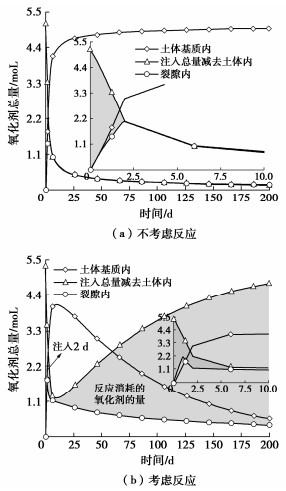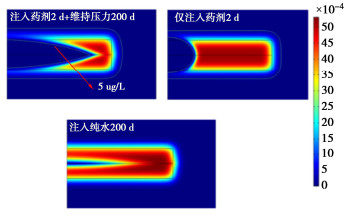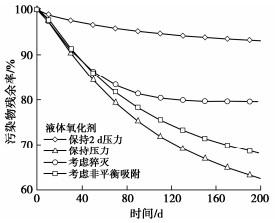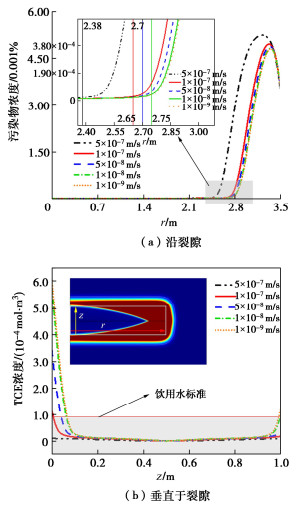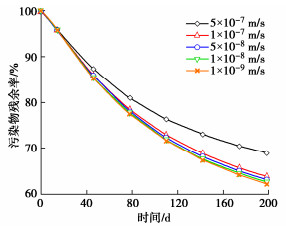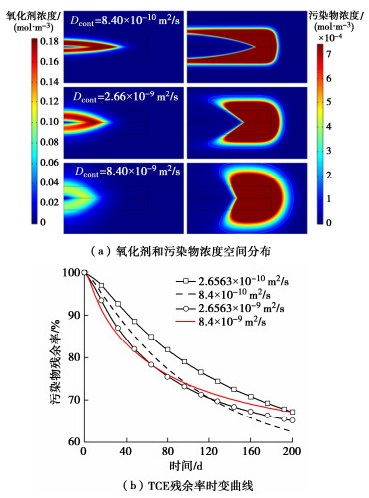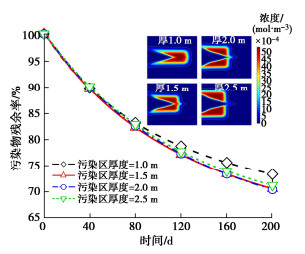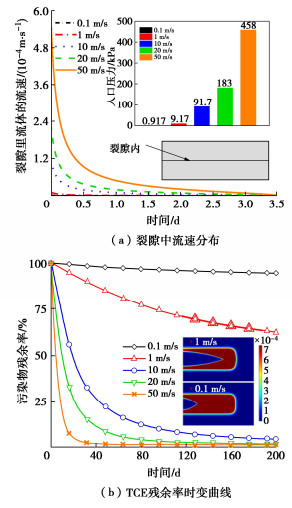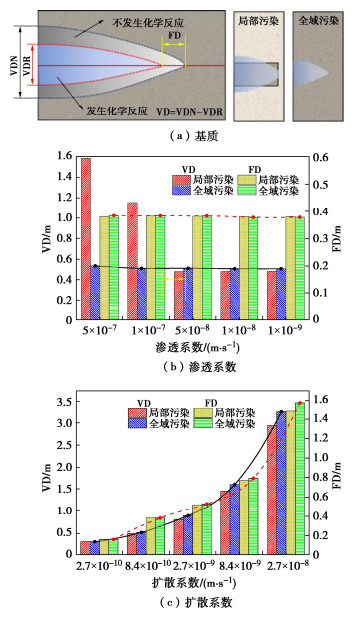Mechanism and application of in-situ oxidation in low-permeability strata with a single fracture
-
摘要: 低渗透地层具有渗透性差、物质传输困难等特点,传统氧化修复技术(ISCO)难以满足需求,而压裂可以形成优势渗流通道,提升注入氧化剂的影响范围,但目前对压裂协同氧化机制的认识仍不足,相应的设计指南也极为缺乏。因此,考虑复合溶质对流、扩散、反应和天然需氧量(NOD),建立了单裂隙低渗透地层ISCO修复二维轴对称模型,揭示了氧化剂沿孔隙-裂隙多尺度结构的迁移转化与修复机制,研究了注入压力、氧化剂猝灭、污染物非平衡吸附、基质渗透和扩散系数及污染物分布特征对修复效率的影响规律,结果表明压裂ISCO修复技术更适用于基质渗透系数≤10-7 m/s且扩散系数≤8.4×10-10 m2/s的低渗透污染地层,且裂隙宜布置在污染羽中下层、氧化剂注入后需持续维持水头,否则修复效果欠佳。最后,对比了不考虑和考虑反应条件下氧化剂的径向和垂向影响范围,提出了相应的设计思路,为压裂増渗协同修复技术的完善提供一定的理论依据。Abstract: The low-permeability strata are characterized by poor permeability and difficulty in substance transport. The traditional in-situ chemical oxidation (ISCO) techniques often fall short in addressing these challenges. Hydraulic fracturing creates advantageous flow channels, enhancing the ranges of injected oxidants. However, the current understanding of the synergistic mechanism between fracturing and oxidation remains limited, leading to a lack of corresponding design guidelines. Thus, this study considers compound solute advection, diffusion, reactions and natural oxidant demand (NOD) to establish a two-dimensional axisymmetric model for ISCO remediation in low-permeability strata with a single fracture. It reveals the migration and transformation mechanisms of oxidants across pore-fracture multiscale structures, investigating the influences of injection pressure, oxidant quenching, non-equilibrium adsorption of contaminants, matrix permeability, diffusion coefficients and pollutant distribution on remediation efficiency. The results indicate that the hydraulic fracturing ISCO is more suitable for low-permeability contaminated strata with matrix permeability ≤10-7 m/s and diffusion coefficients ≤8.4×10-10 m2/s. Placing fractures in the lower layer of the contaminant plume is suggested, maintaining hydraulic head post-oxidant injection for optimal remediation. Finally, comparisons of radial and vertical ranges of oxidants between with and without considering reaction conditions are made, proposing the corresponding design strategies to refine synergistic hydraulic fracturing-enhanced remediation technologies based on the theoretical foundations.
-
-
表 1 模拟所用的基本参数
Table 1 Values of parameters in simulation
参数 符号含义 单位 参数值 文献 土体参数 ns 基质孔隙率 1 0.42 文献[22] ks 基质渗透系数 m/s 10-8 文献[22] ρd 土体干密度 kg/m3 1700 裂隙参数 df 裂隙孔径 cm 1 文献[25] Df 裂隙深度 m 5 文献[27] nf 裂隙孔隙率 1 0.7 文献[25] 反应物基本参数 MMnO4- 高锰酸钾摩尔质量 g/mol 158 文献[23] MTCE TCE摩尔质量 g/mol 131 文献[23] DMnO4- 氧化剂扩散
系数m2/s 1.4×10-9 文献[24] DTCE TCE扩散系数 m2/s 8.4×10-10 文献[24] kreact 反应速率常数 m3/mol/s 6.5×10-4 文献[26] a 理想状态下
摩尔比1 2 Cs 高锰酸钾溶
解度kg/m3 63.99 -
[1] 陈能场, 郑煜基, 何晓峰, 等. 《全国土壤污染状况调查公报》探析[J]. 农业环境科学学报, 2017, 36(9): 1689-1692. CHEN Nengchang, ZHENG Yuji, HE Xiaofeng, et al. Analysis of the report on the national general survey of soil contamination[J]. Journal of Agro-Environment Science, 2017, 36(9): 1689-1692. (in Chinese)
[2] 孟宪荣, 许伟, 张建荣. 化工污染场地氯苯分布特征[J]. 土壤, 2019, 51(6): 1144-1150. MENG Xianrong, XU Wei, ZHANG Jianrong. Distribution characters of chlorobenzene in polluted chemical industrial site[J]. Soils, 2019, 51(6): 1144-1150. (in Chinese)
[3] SIEGRIST R L A C. In Situ Chemical Oxidation for Groundwater Remediation[M]. New York: Springer, 2011.
[4] YEH C K J, WU H M, CHEN T C. Chemical oxidation of chlorinated non-aqueous phase liquid by hydrogen peroxide in natural sand systems[J]. Journal of Hazardous Materials, 2003, 96(1): 29-51. doi: 10.1016/S0304-3894(02)00147-4
[5] GAO L Z, ZHUANG J, NIE L, et al. Intrinsic peroxidase-like activity of ferromagnetic nanoparticles[J]. Nature Nanotechnology, 2007, 2(9): 577-583. doi: 10.1038/nnano.2007.260
[6] LEE E S, SCHWARTZ F W. Characteristics and applications of controlled-release KMnO4 for groundwater remediation[J]. Chemosphere, 2007, 66(11): 2058-2066. doi: 10.1016/j.chemosphere.2006.09.093
[7] HEIDERSCHEIDT J L, CRIMI M, SIEGRIST R L, et al. Optimization of full-scale permanganate ISCO system operation: laboratory and numerical studies[J]. Groundwater Monitoring & Remediation, 2008, 28(4): 72-84.
[8] REECE J, CHRISTENSON M, KAMBHU A, et al. Remediating contaminated groundwater with an aerated, direct-push, oxidant delivery system[J]. Water, 2020, 12(12): 3383. doi: 10.3390/w12123383
[9] 蒲生彦, 唐菁, 侯国庆, 等. 缓释型化学氧化剂在地下水DNAPLs污染修复中的应用研究进展[J]. 环境化学, 2020, 39(3): 791-799. PU Shengyan, TANG Jing, HOU Guoqing, et al. The application progress of sustained-release chemical oxidants in the remediation of DNAPLs contaminated groundwater[J]. Environmental Chemistry, 2020, 39(3): 791-799. (in Chinese)
[10] HU J, MOOD C G, MEAR M E. An efficient computational framework for height-contained growing and intersecting hydraulic fracturing simulation via SGBEM–FEM[J]. Computer Methods in Applied Mechanics and Engineering, 2024, 419: 116653. doi: 10.1016/j.cma.2023.116653
[11] LHOTSKÝ O, KUKAČKA J, SLUNSKÝ J, et al. The effects of hydraulic/pneumatic fracturing-enhanced remediation (FRAC-IN) at a site contaminated by chlorinated ethenes: a case study[J]. Journal of Hazardous Materials, 2021, 417: 125883. doi: 10.1016/j.jhazmat.2021.125883
[12] MURDOCH L C, SLACK W W. Forms of hydraulic fractures in shallow fine-grained formations[J]. Journal of Geotechnical and Geoenvironmental Engineering, 2002, 128(6): 479-487. doi: 10.1061/(ASCE)1090-0241(2002)128:6(479)
[13] SCHULENBERG J W, REEVES H W. Axi-symmetric simulation of soil vapor extraction influenced by soil fracturing[J]. Journal of Contaminant Hydrology, 2002, 57(3/4): 189-222.
[14] HAUSWIRTH S C, BOWERS C A, FOWLER C P, et al. Modeling cross model non-Newtonian fluid flow in porous media[J]. Journal of Contaminant Hydrology, 2020, 235: 103708. doi: 10.1016/j.jconhyd.2020.103708
[15] HORST J, DIVINE C, SCHNOBRICH M, et al. Groundwater remediation in low-permeability settings: the evolving spectrum of proven and potential [J]. Ground Water Monitoring and Remediation, 2019, 39(1): 11-19. doi: 10.1111/gwmr.12316
[16] FAN D M, GILBERT E J, FOX T. Current state of in situ subsurface remediation by activated carbon-based amendments[J]. Journal of Environmental Management, 2017, 204: 793-803. doi: 10.1016/j.jenvman.2017.02.014
[17] MAHMOODLU M G, HASSANIZADEH S M, HARTOG N. Evaluation of the kinetic oxidation of aqueous volatile organic compounds by permanganate[J]. Science of the Total Environment, 2014, 485: 755-763.
[18] CHA K Y, BORDEN R C. Impact of injection system design on ISCO performance with permanganate—mathematical modeling results[J]. Journal of Contaminant Hydrology, 2012, 128(1/2/3/4): 33-46.
[19] FENG S J, ZHANG X, ZHENG Q T, et al. Modeling the spreading and remediation efficiency of slow-release oxidants in a fractured and contaminated low-permeability stratum[J]. Chemosphere, 2023, 337: 139271. doi: 10.1016/j.chemosphere.2023.139271
[20] GELHAR L W. Stochastic subsurface hydrology from theory to applications[J]. Water Resources Research, 1986, 22(9): 135-145.
[21] GELHAR L W, WELTY C, REHFELDT K R. A critical review of data on field-scale dispersion in aquifers[J]. Water Resources Research, 1992, 28(7): 1955-1974. doi: 10.1029/92WR00607
[22] 朱学愚, 钱孝星. 地下水水文学[M]. 北京: 中国环境科学出版社, 2005. ZHU Xueyu, QIAN Xiaoxing. Groundwater Hydrology[M]. Beijing: China Environmental Science Press, 2005. (in Chinese)
[23] LUCKENBACH R. The Beilstein handbook of organic chemistry: the first hundred years[J]. Journal of Chemical Information and Computer Sciences, 1981, 21(2): 82-83. doi: 10.1021/ci00030a006
[24] YUAN B L, LI F, CHEN Y M, et al. Laboratory-scale column study for remediation of TCE-contaminated aquifers using three-section controlled-release potassium permanganate barriers[J]. Journal of Environmental Sciences, 2013, 25(5): 971-977. doi: 10.1016/S1001-0742(12)60134-X
[25] TZOVOLOU D N, AGGELOPOULOS C A, THEODOROPOULOU M A, et al. Remediation of the unsaturated zone of NAPL-polluted low permeability soils with steam injection: an experimental study[J]. Journal of Soils and Sediments, 2011, 11(1): 72-81. doi: 10.1007/s11368-010-0268-5
[26] YAN Y E, SCHWARTZ F W. Oxidative degradation and kinetics of chlorinated ethylenes by potassium permanganate[J]. Journal of Contaminant Hydrology, 1999, 37(3/4): 343-365.
[27] CHRISTENSON M D, KAMBHU A, COMFORT S D. Using slow-release permanganate candles to remove TCE from a low permeable aquifer at a former landfill[J]. Chemosphere, 2012, 89(6): 680-687. doi: 10.1016/j.chemosphere.2012.06.009
[28] KLOTZ D, SEILER K P, MOSER H, et al. Dispersivity and velocity relationship from laboratory and field experiments[J]. Journal of Hydrology, 1980, 45(3/4): 169-184.
[29] CHRISTENSON M, KAMBHU A, REECE J, et al. A five-year performance review of field-scale, slow-release permanganate candles with recommendations for second- generation improvements[J]. Chemosphere, 2016, 150: 239-247. doi: 10.1016/j.chemosphere.2016.01.125
[30] 王浩越, 陈宏信, 冯世进, 等. 非平衡吸附条件下双分子反应性溶质运移规律研究[J]. 岩土工程学报, 2023, 45(12): 2547-2555. doi: 10.11779/CJGE20221063 WANG Haoyue, CHEN Hongxin, FENG Shijin, et al. Migration of bimolecular reactive solutes considering nonequilibrium sorption[J]. Chinese Journal of Geotechnical Engineering, 2023, 45(12): 2547-2555. (in Chinese) doi: 10.11779/CJGE20221063
[31] GOMEZ-TAYLOR M. National primary drinking water regulation for nitrate and nitrite[J]. Abstracts of Papers of the American Chemical Society, 1989, 197.
[32] CHEN H, FENG S J, ZHENG Q T, et al. Enhanced delivery of amendments in fractured clay sites based on multi-point injection: an analytical study[J]. Chemosphere, 2022, 297: 134086. doi: 10.1016/j.chemosphere.2022.134086
-
其他相关附件



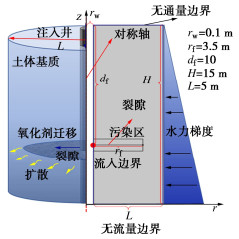
 下载:
下载:
